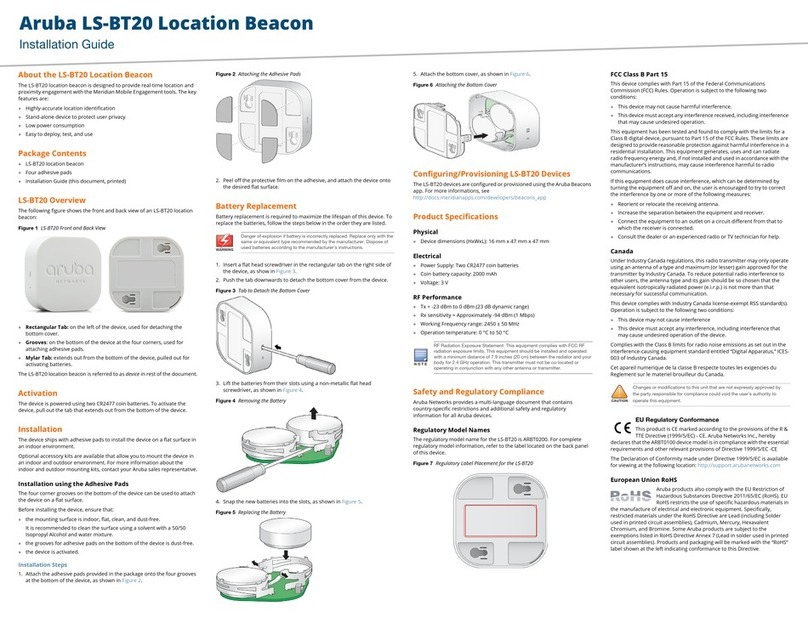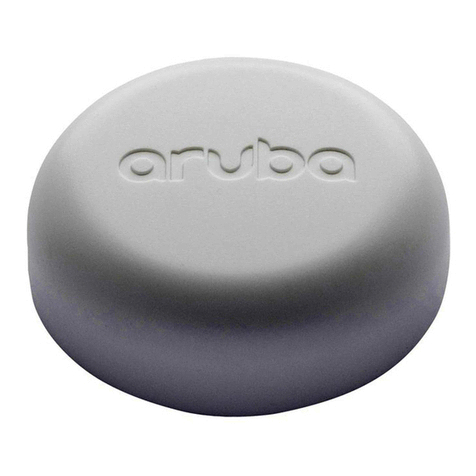
Aruba LS-BT1 Location Beacon
Installation Guide
About the LS-BT1 Location Beacon
The LS-BT1 location beacon is designed to provide real-time location and
proximity engagement with the Meridian Mobile Engagement tools. The key
features are:
Highly-accurate location identification
Stand-alone device to protect user privacy
Low power consumption
Easy to deploy, test, and use
Package Contents
LS-BT1 location beacon
Four adhesive pads
Installation Guide (this document, printed)
LS-BT1 Overview
The following figure shows the front and back view of an LS-BT1 location
beacon:
Figure 1 LS-BT1 Views
Rectangular Tab: on the left of the device, used for detaching the
bottom cover.
Grooves: on the bottom of the device at the four corners, used for
attaching adhesive pads.
Mylar Tab: extends out from the bottom of the device, pulled out for
activating batteries.
The LS-BT1 location beacon is referred to as device in rest of the document.
Activation
The device is powered using two CR2477 coin batteries. To activate the
device, pull out the tab that extends out from the bottom of the device. A
new set of batteries last for approximately one and a half years.
Installation
The device ships with adhesive pads to install the device on a flat surface in
an indoor environment.
Optional accessory kits are available that allows you to mount the device in
an indoor and outdoor environment. For more information about the
indoor and outdoor mounting kits, contact your Aruba sales representative.
Installation using the Adhesive Pads
The four corner grooves on the bottom of the device can be used to attach
the device on a flat surface.
Before installing the device, ensure that:
the mounting surface is indoor, flat, clean, and dust-free.
It is recommended to clean the surface using a solvent with 50/50
Isopropyl Alcohol and water mixture.
the grooves for adhesive pads on the bottom of the device is dust-free.
the device is activated.
Installation Steps
1. Attach the adhesive pads provided in the package onto the four grooves
at the bottom of the device, as shown in Figure 2.
Figure 2 Attaching the Adhesive Pads
2. Peel off the protective film on the adhesive, and attach the device onto
the desired flat surface.
Battery Replacement
1. Insert a flat head screwdriver in the rectangular tab on the right side of
the device, as show in Figure 3.
2. Push the tab downwards to detach the bottom cover from the device.
Figure 3 Tab to Detach the Bottom Cover
3. Lift the batteries from their slots using a flat head screwdriver, as shown
in Figure 4.
Figure 4 Removing the Battery
4. Snap the new batteries into the slots, as shown in Figure 5.
Figure 5 Replacing the Battery
.
5. Attach the bottom cover, as shown in Figure 6.
Figure 6 Attaching the Bottom Cover
Configuring/Provisioning LS-BT1 Devices
The LS-BT1 devices are configured or provisioned using the Aruba Beacons
app. For more informations, see
http://docs.meridianapps.com/developers/beacons_app
Product Specifications
Physical
Device dimensions (HxWxL): 16 mm x 47 mm x 47 mm
Electrical
Power Supply: Two CR2477 coin batteries
Coin battery capacity: 2000 mAh
Voltage: 3 V
RF Performance
Tx = -23 dBm to 0 dBm (23 dB dynamic range)
Rx sensitivity = Approximately -94 dBm (1 Mbps)
Working Frequency range: 2450 ± 50 MHz
Operation temperature: 0 °C to 50 °C
Safety and Regulatory Compliance
Aruba Networks provides a multi-language document that contains
country-specific restrictions and additional safety and regulatory
information for all Aruba devices. This document can be viewed or
downloaded from the following location:
www.arubanetworks.com/safety_addendum
Regulatory Model Names
The regulatory model name applicable to the LS-BT1 location beacon is
ARBT0100.
Japan
FCC Class B Part 15
This device complies with Part 15 of the Federal Communications
Commission (FCC) Rules. Operation is subject to the following two
conditions:
This device may not cause harmful interference.
This device must accept any interference received, including interference
that may cause undesired operation.
This equipment has been tested and found to comply with the limits for a
Class B digital device, pursuant to Part 15 of the FCC Rules. These limits are
designed to provide reasonable protection against harmful interference in a
residential installation. This equipment generates, uses and can radiate
radio frequency energy and, if not installed and used in accordance with the
manufacturer’s instructions, may cause interference harmful to radio
communications.
If this equipment does cause interference, which can be determined by
turning the equipment off and on, the user is encouraged to try to correct
the interference by one or more of the following measures:
Reorient or relocate the receiving antenna.
Increase the separation between the equipment and receiver.
Connect the equipment to an outlet on a circuit different from that to
which the receiver is connected.
Consult the dealer or an experienced radio or TV technician for help.
Canada
Under Industry Canada regulations, this radio transmitter may only operate
using an antenna of a type and maximum (or lesser) gain approved for the
transmitter by Industry Canada. To reduce potential radio interference to
other users, the antenna type and its gain should be so chosen that the
equivalent isotropically radiated power (e.i.r.p.) is not more than that
necessary for successful communication.
This device complies with Industry Canada licence-exempt RSS standard(s).
Operation is subject to the following two conditions:
This device may not cause interference
This device must accept any interference, including interference that
may cause undesired operation of the device.
Complies with the Class B limits for radio noise emissions as set out in the
interference-causing equipment standard entitled “Digital Apparatus,” ICES-
003 of Industry Canada.
Cet apareil numerique de la classe B respecte toutes les exigencies du
Reglement sur le materiel brouilleur du Canada.
EU Regulatory Conformance
This product is CE marked according to the provisions of the R &
TTE Directive (1999/5/EC) - CE. Aruba Networks Inc., hereby
declares that the ARBT0100 device model is in compliance with the essential
requirements and other relevant provisions of Directive 1999/5/EC -CE
The Declaration of Conformity made under Directive 1999/5/EC is available
for viewing at the following location: http://support.arubanetworks.com
European Union RoHS
Aruba products also comply with the EU Restriction of
Hazardous Substances Directive 2011/65/EC (RoHS). EU
RoHS restricts the use of specific hazardous materials in
the manufacture of electrical and electronic equipment. Specifically,
restricted materials under the RoHS Directive are Lead (including Solder
used in printed circuit assemblies), Cadmium, Mercury, Hexavalent
Chromium, and Bromine. Some Aruba products are subject to the
Danger of explosion if battery is incorrectly replaced. Replace only with the
same or equivalent type recommended by the manufacturer. Dispose of
used batteries according to the manufacturer's instructions.
RF Radiation Exposure Statement: This equipment complies with FCC RF
radiation exposure limits. This equipment should be installed and operated
with a minimum distance of 7.9 inches (20 cm) between the radiator and your
body for 2.4 GHz operation. This transmitter must not be co-located or
operating in conjunction with any other antenna or transmitter.
Aruba Networks, Inc
Model: ARBT0100
FCC ID Q9DBT100
IC: 4675A-BT100
CMIIT ID: 2014DJ5526
SUBTEL: 0588/DFRS19996/F-50
ETA-006/2015-RLO(SR)/450 052
&&$-/37
HK0011501143
DB101525
Type-Approval No.
ESD-1510132C
OMAN - TRA
R/2344/15
D080134
TRA
REGISTERED No:
DEALER No:
DA0039425/10
ER37558/15
201-140502
CAN ICES-3 (B)/NMB-3(B)
TA-2014/2509
MSIP-CRM-ARU-ARBR0100
Changes or modifications to this unit that are not expressly approved by
the party responsible for compliance could void the user’s authority to
operate this equipment.





















